HI6026 Audit, Assurance and Compliance: DIPL Case Study Analysis
VerifiedAdded on 2020/03/04
|10
|2255
|40
Case Study
AI Summary
This document presents a comprehensive case study analysis of the audit of Double Ink Printers Ltd (DIPL). The analysis begins with an overview of the audit process, emphasizing the auditor's role in assessing financial statements and the application of substantive and analytical audit procedures. The study examines key financial ratios and trends over three years, including current, liquid, debt-equity, net profit, and return on equity ratios. It then delves into the identification of audit risks, specifically inherent, control, and detection risks, within DIPL's operations, including risks related to non-routine transactions, the implementation of a new IT system, and changes in accounting policies. The case study also explores potential fraud risks, such as the lack of segregation of duties and issues related to the hasty installation of the new IT system. Finally, it outlines the auditor's approach to mitigating these risks through appropriate procedures, such as verifying accounts, seeking expert opinions, and reconciling financial records.
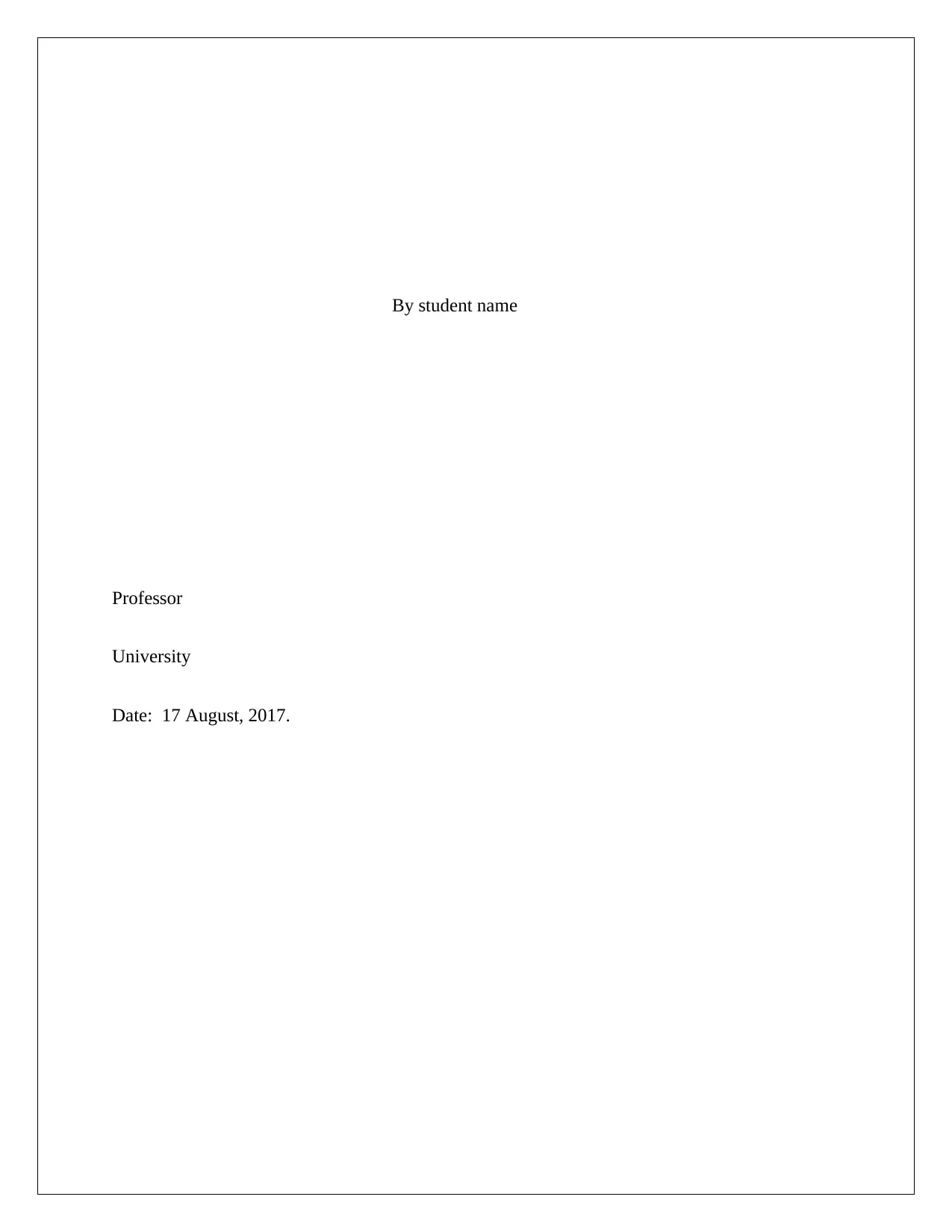
By student name
Professor
University
Date: 17 August, 2017.
Professor
University
Date: 17 August, 2017.
Paraphrase This Document
Need a fresh take? Get an instant paraphrase of this document with our AI Paraphraser
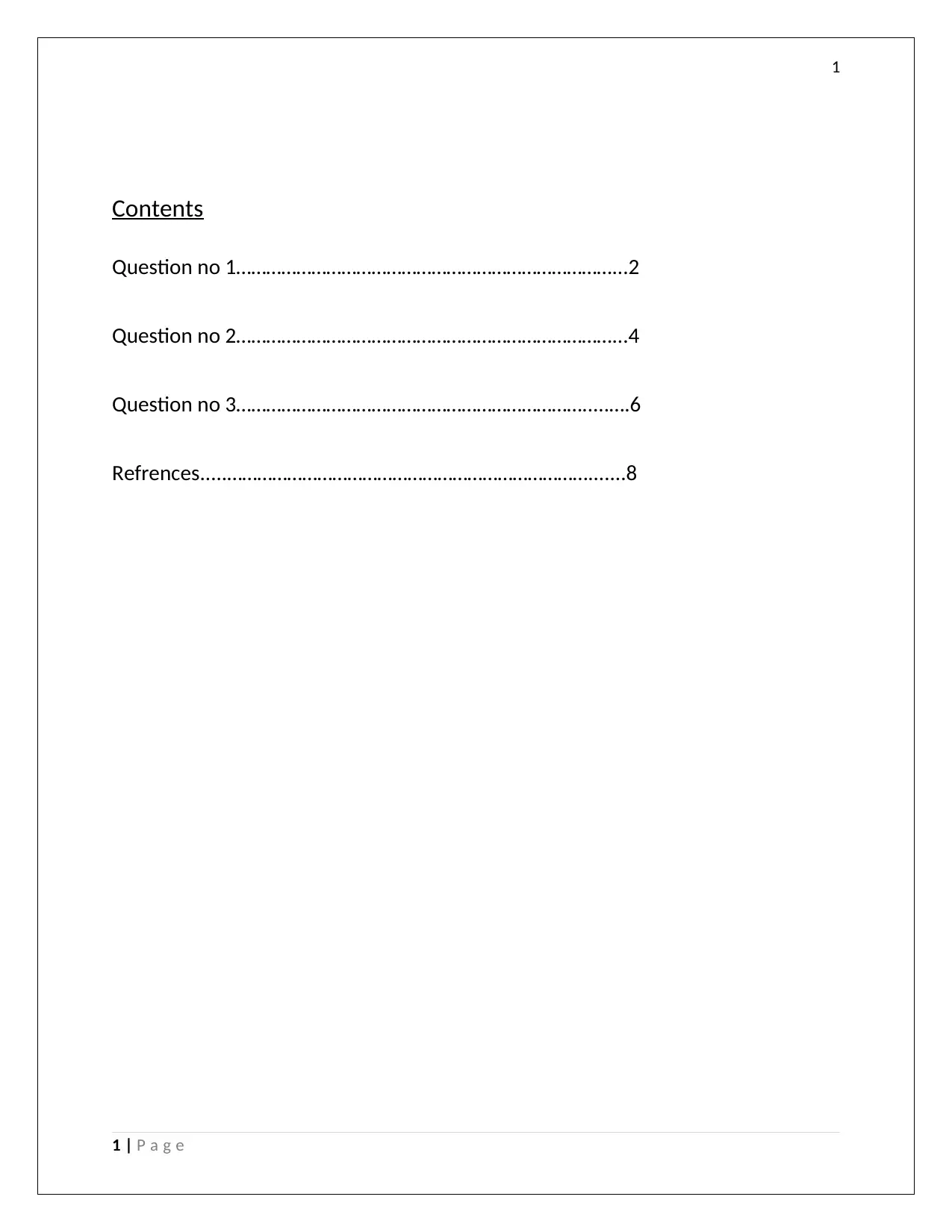
1
Contents
Question no 1…………………………………………………………………...2
Question no 2…………………………………………………………………...4
Question no 3…………………………………………………………….....….6
Refrences.....……………………………………………………………….......8
1 | P a g e
Contents
Question no 1…………………………………………………………………...2
Question no 2…………………………………………………………………...4
Question no 3…………………………………………………………….....….6
Refrences.....……………………………………………………………….......8
1 | P a g e
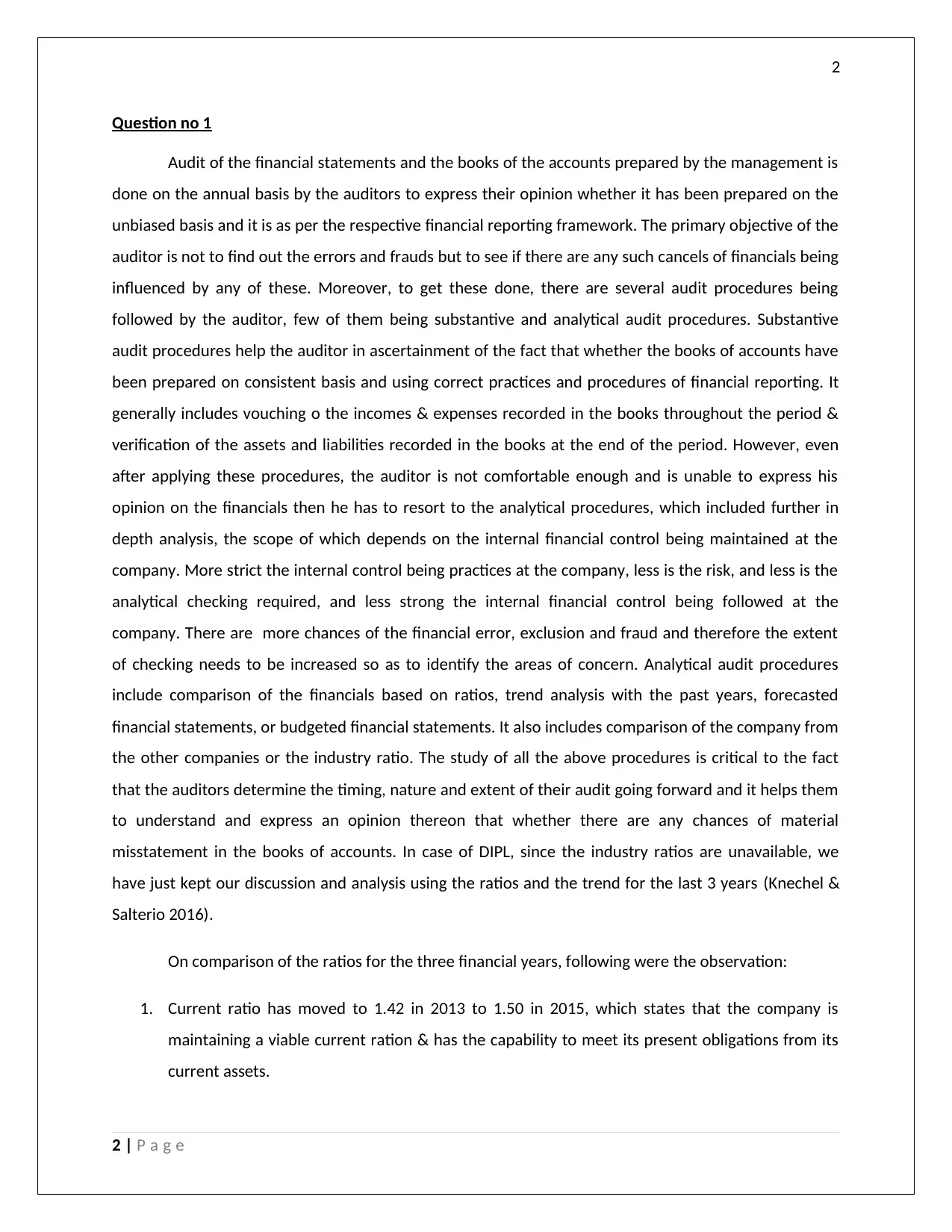
2
Question no 1
Audit of the financial statements and the books of the accounts prepared by the management is
done on the annual basis by the auditors to express their opinion whether it has been prepared on the
unbiased basis and it is as per the respective financial reporting framework. The primary objective of the
auditor is not to find out the errors and frauds but to see if there are any such cancels of financials being
influenced by any of these. Moreover, to get these done, there are several audit procedures being
followed by the auditor, few of them being substantive and analytical audit procedures. Substantive
audit procedures help the auditor in ascertainment of the fact that whether the books of accounts have
been prepared on consistent basis and using correct practices and procedures of financial reporting. It
generally includes vouching o the incomes & expenses recorded in the books throughout the period &
verification of the assets and liabilities recorded in the books at the end of the period. However, even
after applying these procedures, the auditor is not comfortable enough and is unable to express his
opinion on the financials then he has to resort to the analytical procedures, which included further in
depth analysis, the scope of which depends on the internal financial control being maintained at the
company. More strict the internal control being practices at the company, less is the risk, and less is the
analytical checking required, and less strong the internal financial control being followed at the
company. There are more chances of the financial error, exclusion and fraud and therefore the extent
of checking needs to be increased so as to identify the areas of concern. Analytical audit procedures
include comparison of the financials based on ratios, trend analysis with the past years, forecasted
financial statements, or budgeted financial statements. It also includes comparison of the company from
the other companies or the industry ratio. The study of all the above procedures is critical to the fact
that the auditors determine the timing, nature and extent of their audit going forward and it helps them
to understand and express an opinion thereon that whether there are any chances of material
misstatement in the books of accounts. In case of DIPL, since the industry ratios are unavailable, we
have just kept our discussion and analysis using the ratios and the trend for the last 3 years (Knechel &
Salterio 2016).
On comparison of the ratios for the three financial years, following were the observation:
1. Current ratio has moved to 1.42 in 2013 to 1.50 in 2015, which states that the company is
maintaining a viable current ration & has the capability to meet its present obligations from its
current assets.
2 | P a g e
Question no 1
Audit of the financial statements and the books of the accounts prepared by the management is
done on the annual basis by the auditors to express their opinion whether it has been prepared on the
unbiased basis and it is as per the respective financial reporting framework. The primary objective of the
auditor is not to find out the errors and frauds but to see if there are any such cancels of financials being
influenced by any of these. Moreover, to get these done, there are several audit procedures being
followed by the auditor, few of them being substantive and analytical audit procedures. Substantive
audit procedures help the auditor in ascertainment of the fact that whether the books of accounts have
been prepared on consistent basis and using correct practices and procedures of financial reporting. It
generally includes vouching o the incomes & expenses recorded in the books throughout the period &
verification of the assets and liabilities recorded in the books at the end of the period. However, even
after applying these procedures, the auditor is not comfortable enough and is unable to express his
opinion on the financials then he has to resort to the analytical procedures, which included further in
depth analysis, the scope of which depends on the internal financial control being maintained at the
company. More strict the internal control being practices at the company, less is the risk, and less is the
analytical checking required, and less strong the internal financial control being followed at the
company. There are more chances of the financial error, exclusion and fraud and therefore the extent
of checking needs to be increased so as to identify the areas of concern. Analytical audit procedures
include comparison of the financials based on ratios, trend analysis with the past years, forecasted
financial statements, or budgeted financial statements. It also includes comparison of the company from
the other companies or the industry ratio. The study of all the above procedures is critical to the fact
that the auditors determine the timing, nature and extent of their audit going forward and it helps them
to understand and express an opinion thereon that whether there are any chances of material
misstatement in the books of accounts. In case of DIPL, since the industry ratios are unavailable, we
have just kept our discussion and analysis using the ratios and the trend for the last 3 years (Knechel &
Salterio 2016).
On comparison of the ratios for the three financial years, following were the observation:
1. Current ratio has moved to 1.42 in 2013 to 1.50 in 2015, which states that the company is
maintaining a viable current ration & has the capability to meet its present obligations from its
current assets.
2 | P a g e
⊘ This is a preview!⊘
Do you want full access?
Subscribe today to unlock all pages.

Trusted by 1+ million students worldwide
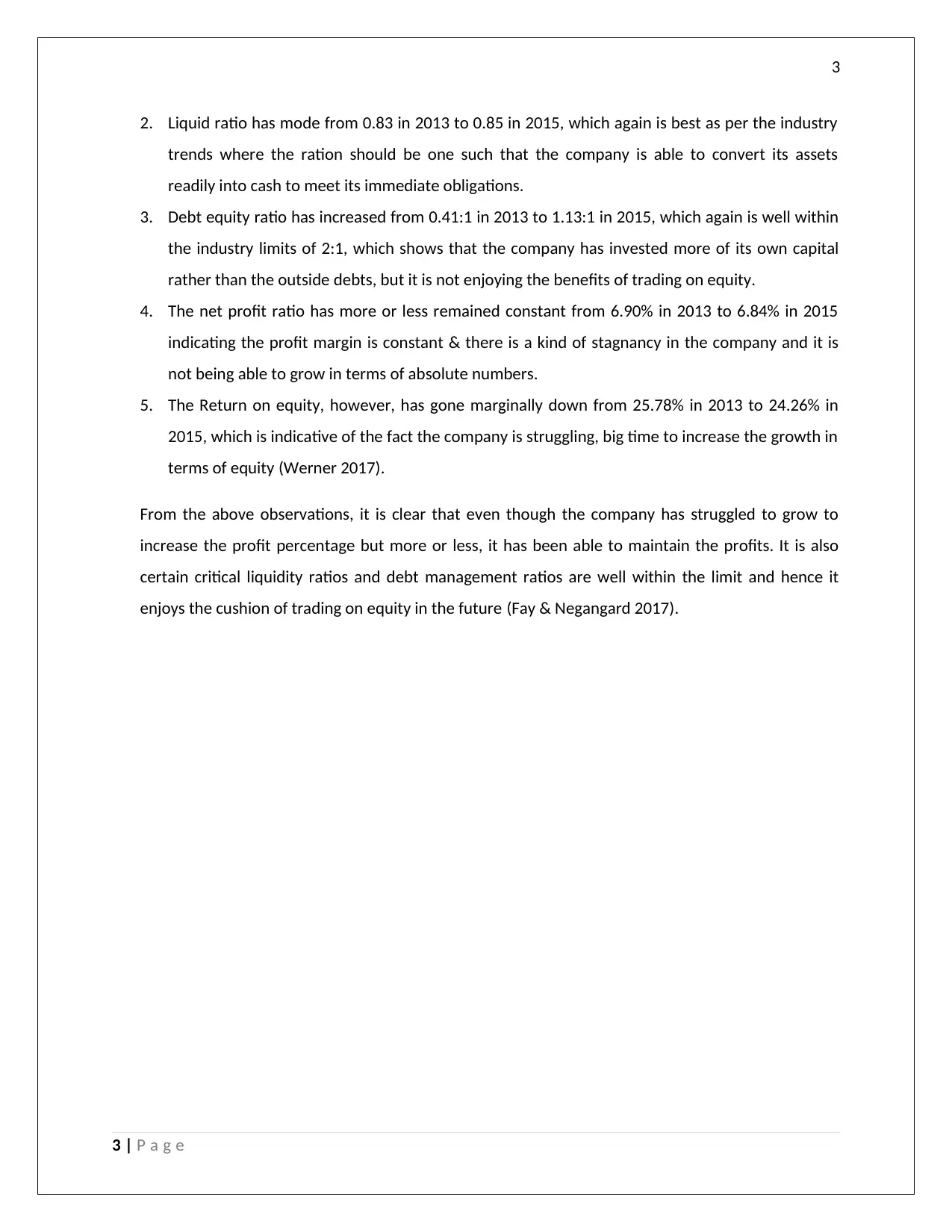
3
2. Liquid ratio has mode from 0.83 in 2013 to 0.85 in 2015, which again is best as per the industry
trends where the ration should be one such that the company is able to convert its assets
readily into cash to meet its immediate obligations.
3. Debt equity ratio has increased from 0.41:1 in 2013 to 1.13:1 in 2015, which again is well within
the industry limits of 2:1, which shows that the company has invested more of its own capital
rather than the outside debts, but it is not enjoying the benefits of trading on equity.
4. The net profit ratio has more or less remained constant from 6.90% in 2013 to 6.84% in 2015
indicating the profit margin is constant & there is a kind of stagnancy in the company and it is
not being able to grow in terms of absolute numbers.
5. The Return on equity, however, has gone marginally down from 25.78% in 2013 to 24.26% in
2015, which is indicative of the fact the company is struggling, big time to increase the growth in
terms of equity (Werner 2017).
From the above observations, it is clear that even though the company has struggled to grow to
increase the profit percentage but more or less, it has been able to maintain the profits. It is also
certain critical liquidity ratios and debt management ratios are well within the limit and hence it
enjoys the cushion of trading on equity in the future (Fay & Negangard 2017).
3 | P a g e
2. Liquid ratio has mode from 0.83 in 2013 to 0.85 in 2015, which again is best as per the industry
trends where the ration should be one such that the company is able to convert its assets
readily into cash to meet its immediate obligations.
3. Debt equity ratio has increased from 0.41:1 in 2013 to 1.13:1 in 2015, which again is well within
the industry limits of 2:1, which shows that the company has invested more of its own capital
rather than the outside debts, but it is not enjoying the benefits of trading on equity.
4. The net profit ratio has more or less remained constant from 6.90% in 2013 to 6.84% in 2015
indicating the profit margin is constant & there is a kind of stagnancy in the company and it is
not being able to grow in terms of absolute numbers.
5. The Return on equity, however, has gone marginally down from 25.78% in 2013 to 24.26% in
2015, which is indicative of the fact the company is struggling, big time to increase the growth in
terms of equity (Werner 2017).
From the above observations, it is clear that even though the company has struggled to grow to
increase the profit percentage but more or less, it has been able to maintain the profits. It is also
certain critical liquidity ratios and debt management ratios are well within the limit and hence it
enjoys the cushion of trading on equity in the future (Fay & Negangard 2017).
3 | P a g e
Paraphrase This Document
Need a fresh take? Get an instant paraphrase of this document with our AI Paraphraser
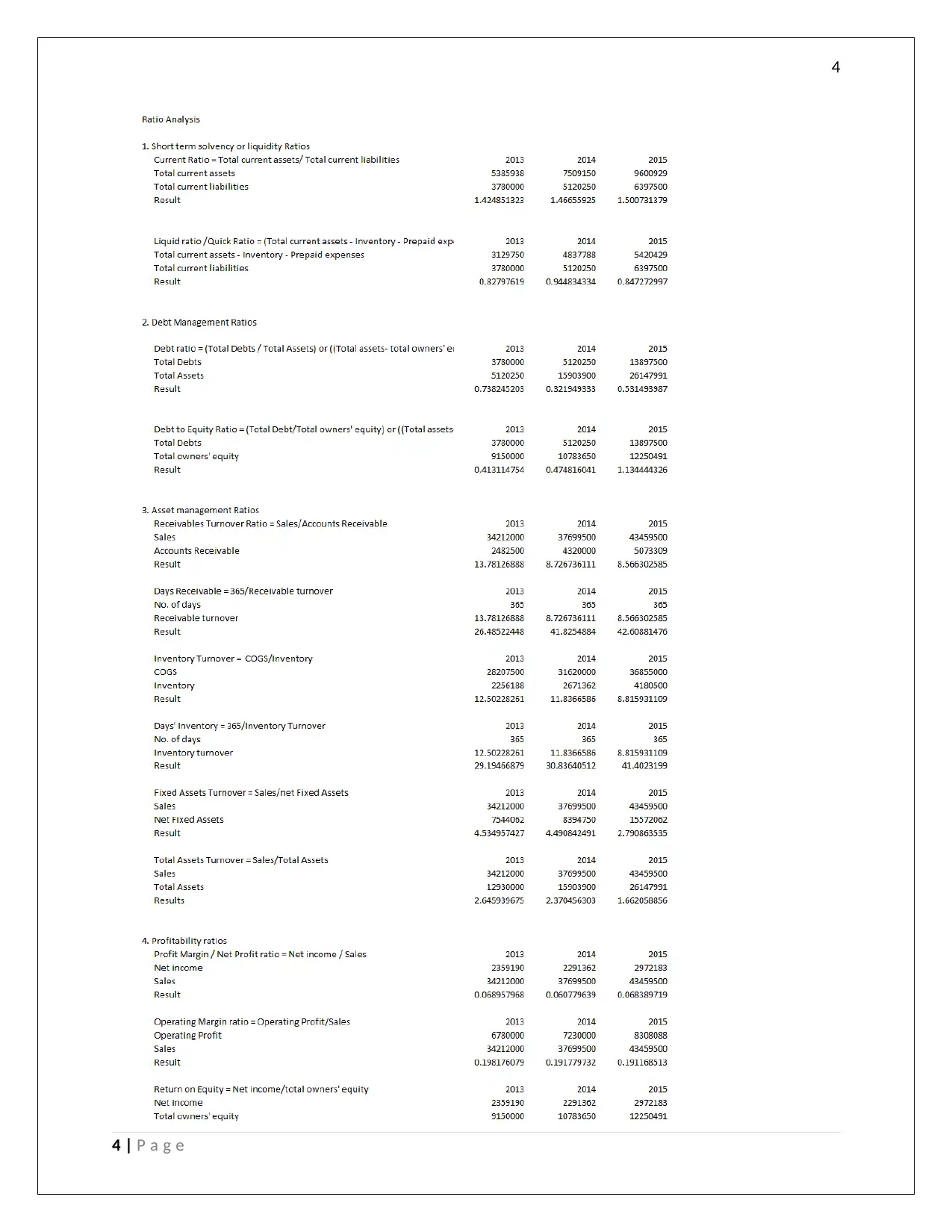
4
Question no 2
4 | P a g e
Question no 2
4 | P a g e
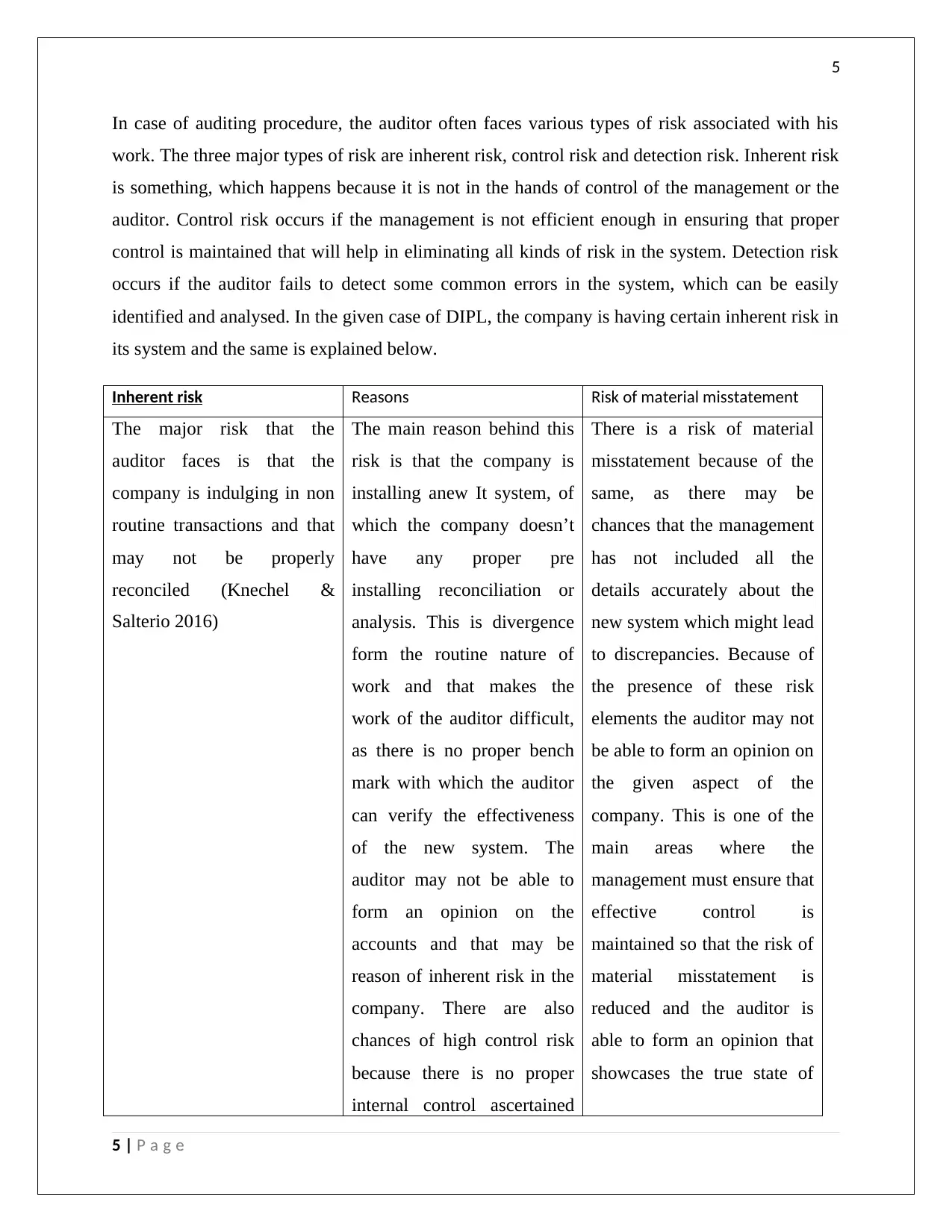
5
In case of auditing procedure, the auditor often faces various types of risk associated with his
work. The three major types of risk are inherent risk, control risk and detection risk. Inherent risk
is something, which happens because it is not in the hands of control of the management or the
auditor. Control risk occurs if the management is not efficient enough in ensuring that proper
control is maintained that will help in eliminating all kinds of risk in the system. Detection risk
occurs if the auditor fails to detect some common errors in the system, which can be easily
identified and analysed. In the given case of DIPL, the company is having certain inherent risk in
its system and the same is explained below.
Inherent risk Reasons Risk of material misstatement
The major risk that the
auditor faces is that the
company is indulging in non
routine transactions and that
may not be properly
reconciled (Knechel &
Salterio 2016)
The main reason behind this
risk is that the company is
installing anew It system, of
which the company doesn’t
have any proper pre
installing reconciliation or
analysis. This is divergence
form the routine nature of
work and that makes the
work of the auditor difficult,
as there is no proper bench
mark with which the auditor
can verify the effectiveness
of the new system. The
auditor may not be able to
form an opinion on the
accounts and that may be
reason of inherent risk in the
company. There are also
chances of high control risk
because there is no proper
internal control ascertained
There is a risk of material
misstatement because of the
same, as there may be
chances that the management
has not included all the
details accurately about the
new system which might lead
to discrepancies. Because of
the presence of these risk
elements the auditor may not
be able to form an opinion on
the given aspect of the
company. This is one of the
main areas where the
management must ensure that
effective control is
maintained so that the risk of
material misstatement is
reduced and the auditor is
able to form an opinion that
showcases the true state of
5 | P a g e
In case of auditing procedure, the auditor often faces various types of risk associated with his
work. The three major types of risk are inherent risk, control risk and detection risk. Inherent risk
is something, which happens because it is not in the hands of control of the management or the
auditor. Control risk occurs if the management is not efficient enough in ensuring that proper
control is maintained that will help in eliminating all kinds of risk in the system. Detection risk
occurs if the auditor fails to detect some common errors in the system, which can be easily
identified and analysed. In the given case of DIPL, the company is having certain inherent risk in
its system and the same is explained below.
Inherent risk Reasons Risk of material misstatement
The major risk that the
auditor faces is that the
company is indulging in non
routine transactions and that
may not be properly
reconciled (Knechel &
Salterio 2016)
The main reason behind this
risk is that the company is
installing anew It system, of
which the company doesn’t
have any proper pre
installing reconciliation or
analysis. This is divergence
form the routine nature of
work and that makes the
work of the auditor difficult,
as there is no proper bench
mark with which the auditor
can verify the effectiveness
of the new system. The
auditor may not be able to
form an opinion on the
accounts and that may be
reason of inherent risk in the
company. There are also
chances of high control risk
because there is no proper
internal control ascertained
There is a risk of material
misstatement because of the
same, as there may be
chances that the management
has not included all the
details accurately about the
new system which might lead
to discrepancies. Because of
the presence of these risk
elements the auditor may not
be able to form an opinion on
the given aspect of the
company. This is one of the
main areas where the
management must ensure that
effective control is
maintained so that the risk of
material misstatement is
reduced and the auditor is
able to form an opinion that
showcases the true state of
5 | P a g e
⊘ This is a preview!⊘
Do you want full access?
Subscribe today to unlock all pages.

Trusted by 1+ million students worldwide
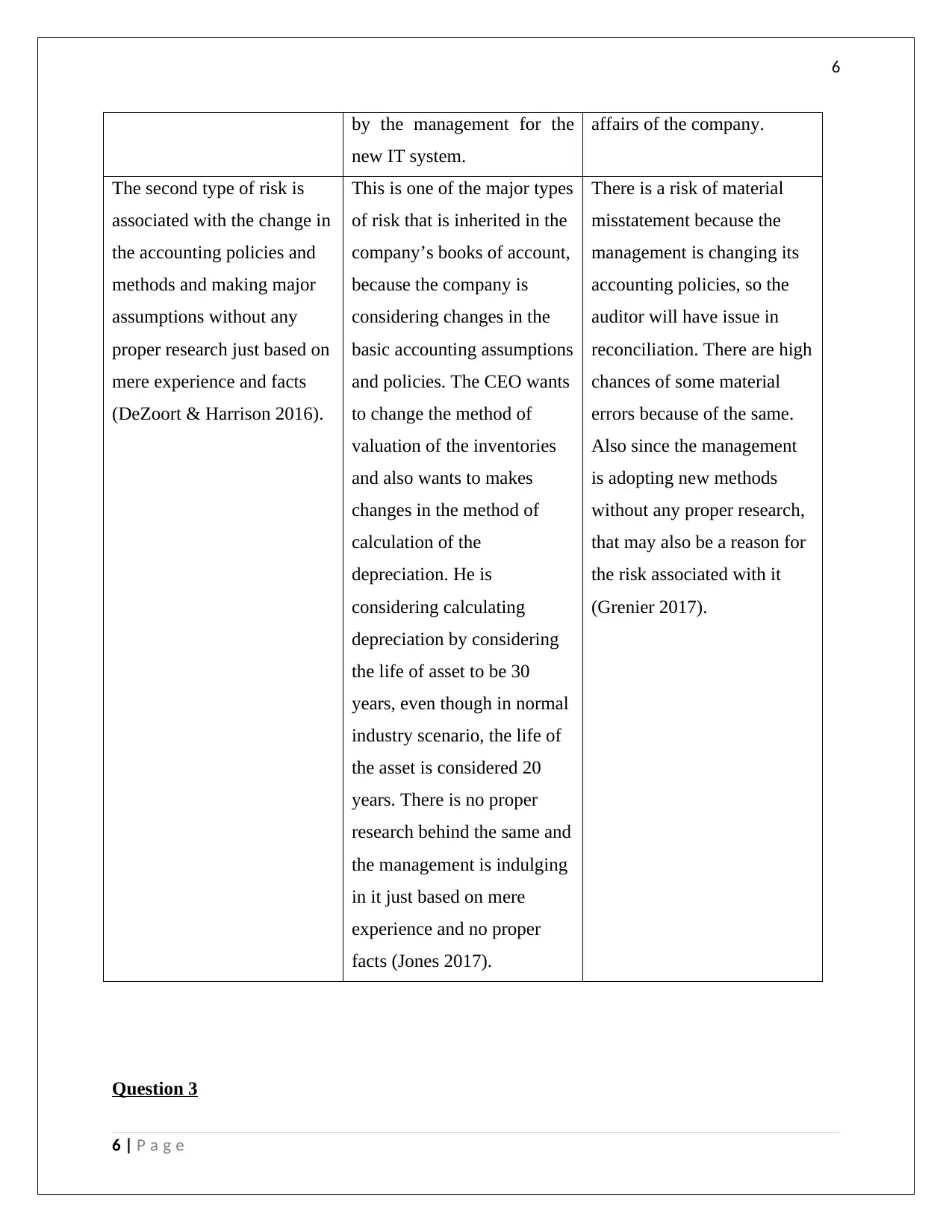
6
by the management for the
new IT system.
affairs of the company.
The second type of risk is
associated with the change in
the accounting policies and
methods and making major
assumptions without any
proper research just based on
mere experience and facts
(DeZoort & Harrison 2016).
This is one of the major types
of risk that is inherited in the
company’s books of account,
because the company is
considering changes in the
basic accounting assumptions
and policies. The CEO wants
to change the method of
valuation of the inventories
and also wants to makes
changes in the method of
calculation of the
depreciation. He is
considering calculating
depreciation by considering
the life of asset to be 30
years, even though in normal
industry scenario, the life of
the asset is considered 20
years. There is no proper
research behind the same and
the management is indulging
in it just based on mere
experience and no proper
facts (Jones 2017).
There is a risk of material
misstatement because the
management is changing its
accounting policies, so the
auditor will have issue in
reconciliation. There are high
chances of some material
errors because of the same.
Also since the management
is adopting new methods
without any proper research,
that may also be a reason for
the risk associated with it
(Grenier 2017).
Question 3
6 | P a g e
by the management for the
new IT system.
affairs of the company.
The second type of risk is
associated with the change in
the accounting policies and
methods and making major
assumptions without any
proper research just based on
mere experience and facts
(DeZoort & Harrison 2016).
This is one of the major types
of risk that is inherited in the
company’s books of account,
because the company is
considering changes in the
basic accounting assumptions
and policies. The CEO wants
to change the method of
valuation of the inventories
and also wants to makes
changes in the method of
calculation of the
depreciation. He is
considering calculating
depreciation by considering
the life of asset to be 30
years, even though in normal
industry scenario, the life of
the asset is considered 20
years. There is no proper
research behind the same and
the management is indulging
in it just based on mere
experience and no proper
facts (Jones 2017).
There is a risk of material
misstatement because the
management is changing its
accounting policies, so the
auditor will have issue in
reconciliation. There are high
chances of some material
errors because of the same.
Also since the management
is adopting new methods
without any proper research,
that may also be a reason for
the risk associated with it
(Grenier 2017).
Question 3
6 | P a g e
Paraphrase This Document
Need a fresh take? Get an instant paraphrase of this document with our AI Paraphraser
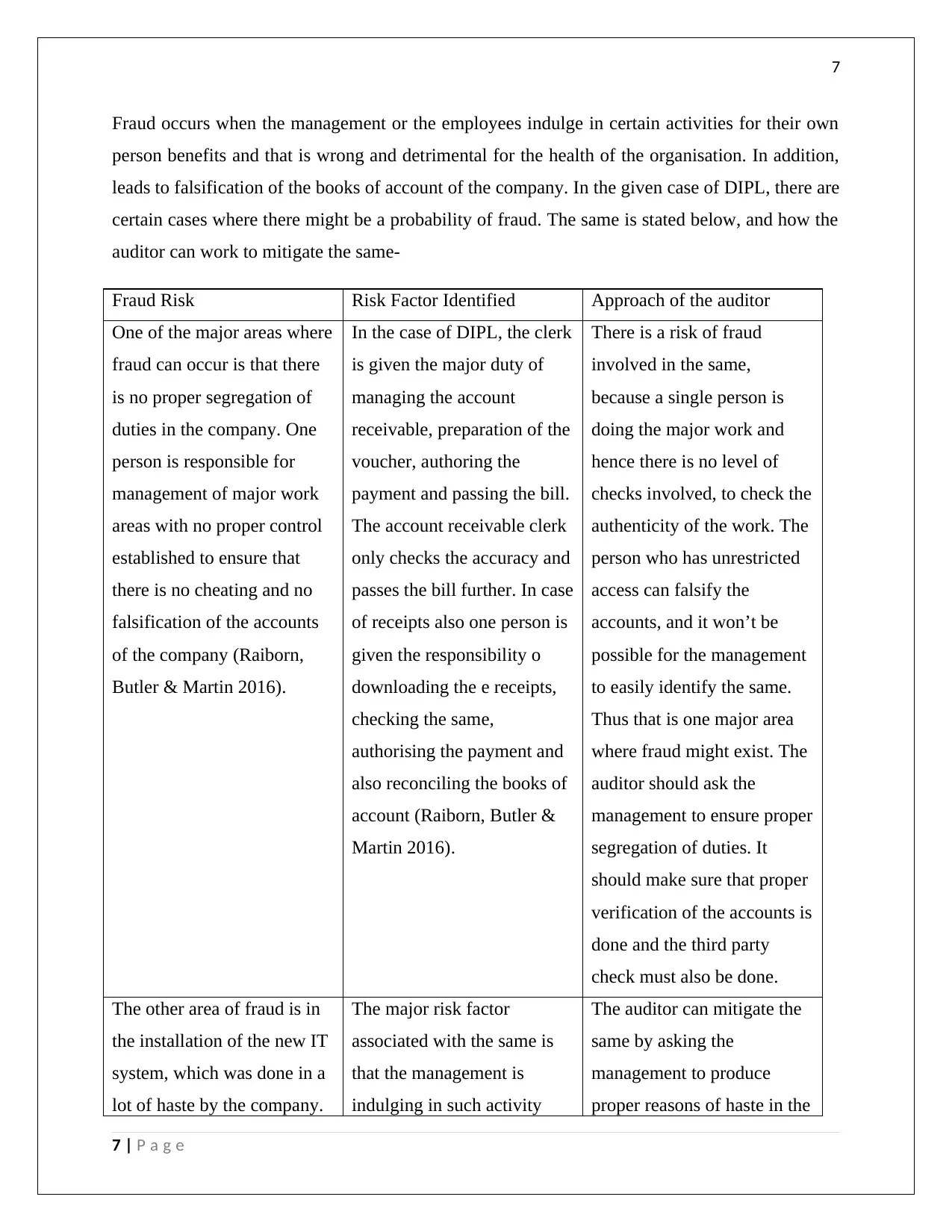
7
Fraud occurs when the management or the employees indulge in certain activities for their own
person benefits and that is wrong and detrimental for the health of the organisation. In addition,
leads to falsification of the books of account of the company. In the given case of DIPL, there are
certain cases where there might be a probability of fraud. The same is stated below, and how the
auditor can work to mitigate the same-
Fraud Risk Risk Factor Identified Approach of the auditor
One of the major areas where
fraud can occur is that there
is no proper segregation of
duties in the company. One
person is responsible for
management of major work
areas with no proper control
established to ensure that
there is no cheating and no
falsification of the accounts
of the company (Raiborn,
Butler & Martin 2016).
In the case of DIPL, the clerk
is given the major duty of
managing the account
receivable, preparation of the
voucher, authoring the
payment and passing the bill.
The account receivable clerk
only checks the accuracy and
passes the bill further. In case
of receipts also one person is
given the responsibility o
downloading the e receipts,
checking the same,
authorising the payment and
also reconciling the books of
account (Raiborn, Butler &
Martin 2016).
There is a risk of fraud
involved in the same,
because a single person is
doing the major work and
hence there is no level of
checks involved, to check the
authenticity of the work. The
person who has unrestricted
access can falsify the
accounts, and it won’t be
possible for the management
to easily identify the same.
Thus that is one major area
where fraud might exist. The
auditor should ask the
management to ensure proper
segregation of duties. It
should make sure that proper
verification of the accounts is
done and the third party
check must also be done.
The other area of fraud is in
the installation of the new IT
system, which was done in a
lot of haste by the company.
The major risk factor
associated with the same is
that the management is
indulging in such activity
The auditor can mitigate the
same by asking the
management to produce
proper reasons of haste in the
7 | P a g e
Fraud occurs when the management or the employees indulge in certain activities for their own
person benefits and that is wrong and detrimental for the health of the organisation. In addition,
leads to falsification of the books of account of the company. In the given case of DIPL, there are
certain cases where there might be a probability of fraud. The same is stated below, and how the
auditor can work to mitigate the same-
Fraud Risk Risk Factor Identified Approach of the auditor
One of the major areas where
fraud can occur is that there
is no proper segregation of
duties in the company. One
person is responsible for
management of major work
areas with no proper control
established to ensure that
there is no cheating and no
falsification of the accounts
of the company (Raiborn,
Butler & Martin 2016).
In the case of DIPL, the clerk
is given the major duty of
managing the account
receivable, preparation of the
voucher, authoring the
payment and passing the bill.
The account receivable clerk
only checks the accuracy and
passes the bill further. In case
of receipts also one person is
given the responsibility o
downloading the e receipts,
checking the same,
authorising the payment and
also reconciling the books of
account (Raiborn, Butler &
Martin 2016).
There is a risk of fraud
involved in the same,
because a single person is
doing the major work and
hence there is no level of
checks involved, to check the
authenticity of the work. The
person who has unrestricted
access can falsify the
accounts, and it won’t be
possible for the management
to easily identify the same.
Thus that is one major area
where fraud might exist. The
auditor should ask the
management to ensure proper
segregation of duties. It
should make sure that proper
verification of the accounts is
done and the third party
check must also be done.
The other area of fraud is in
the installation of the new IT
system, which was done in a
lot of haste by the company.
The major risk factor
associated with the same is
that the management is
indulging in such activity
The auditor can mitigate the
same by asking the
management to produce
proper reasons of haste in the
7 | P a g e
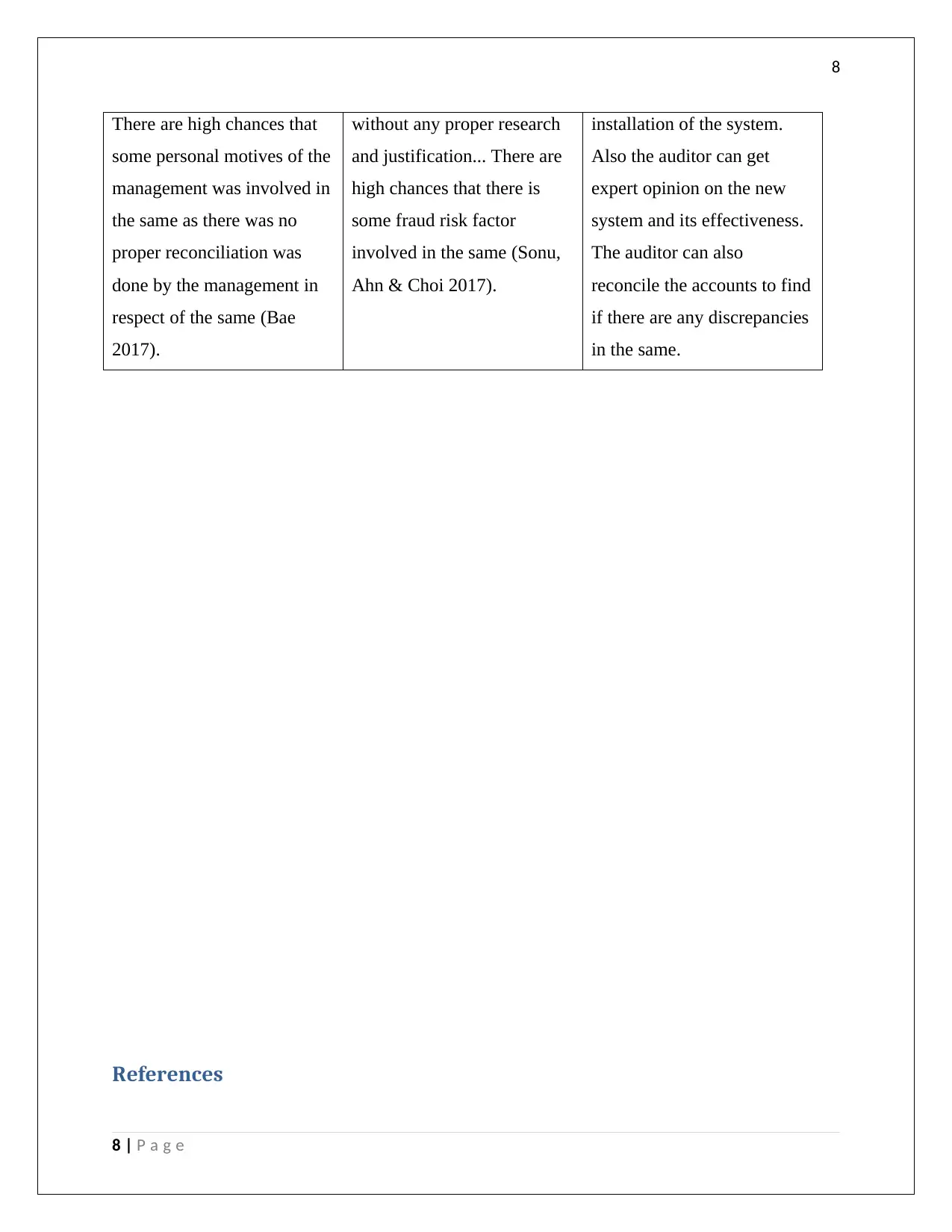
8
There are high chances that
some personal motives of the
management was involved in
the same as there was no
proper reconciliation was
done by the management in
respect of the same (Bae
2017).
without any proper research
and justification... There are
high chances that there is
some fraud risk factor
involved in the same (Sonu,
Ahn & Choi 2017).
installation of the system.
Also the auditor can get
expert opinion on the new
system and its effectiveness.
The auditor can also
reconcile the accounts to find
if there are any discrepancies
in the same.
References
8 | P a g e
There are high chances that
some personal motives of the
management was involved in
the same as there was no
proper reconciliation was
done by the management in
respect of the same (Bae
2017).
without any proper research
and justification... There are
high chances that there is
some fraud risk factor
involved in the same (Sonu,
Ahn & Choi 2017).
installation of the system.
Also the auditor can get
expert opinion on the new
system and its effectiveness.
The auditor can also
reconcile the accounts to find
if there are any discrepancies
in the same.
References
8 | P a g e
⊘ This is a preview!⊘
Do you want full access?
Subscribe today to unlock all pages.

Trusted by 1+ million students worldwide
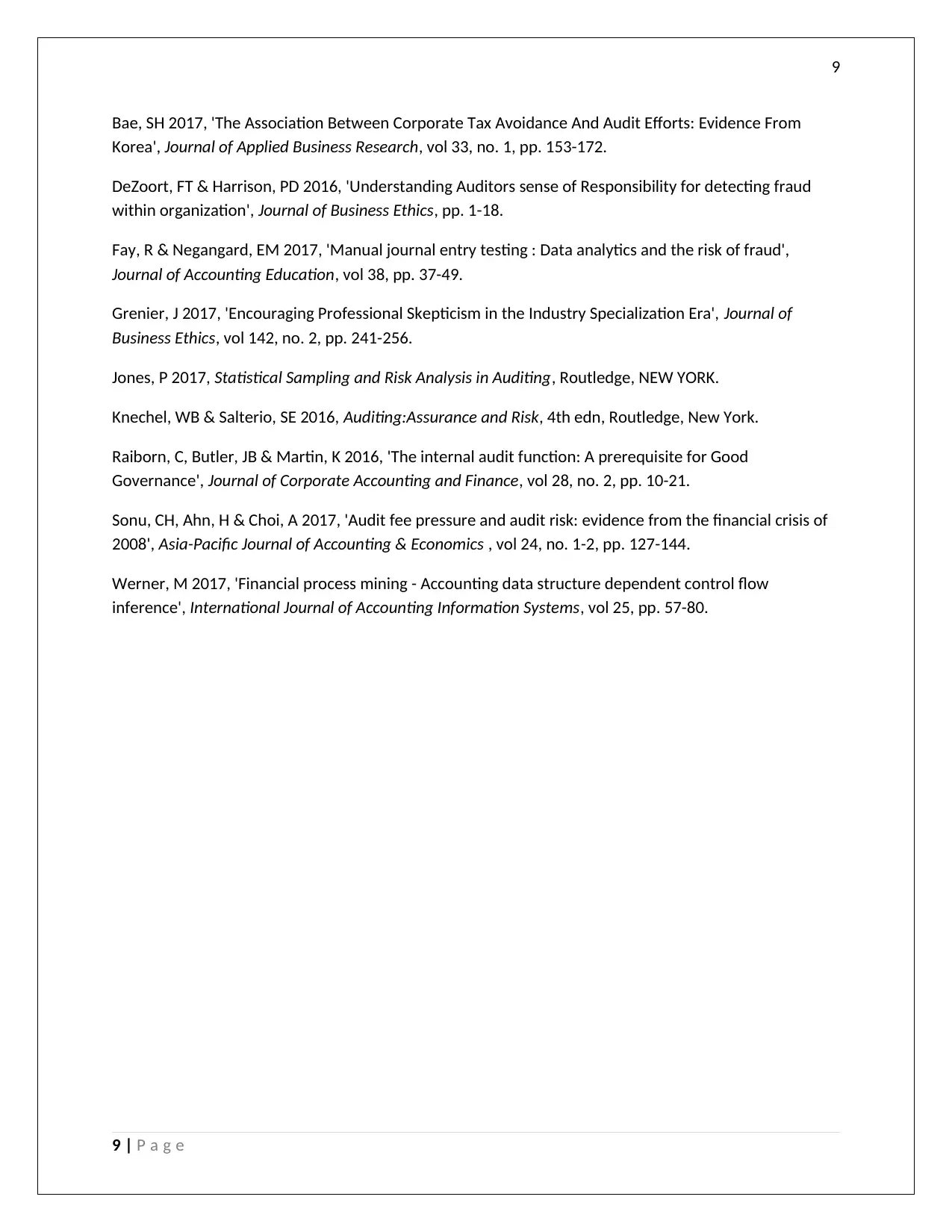
9
Bae, SH 2017, 'The Association Between Corporate Tax Avoidance And Audit Efforts: Evidence From
Korea', Journal of Applied Business Research, vol 33, no. 1, pp. 153-172.
DeZoort, FT & Harrison, PD 2016, 'Understanding Auditors sense of Responsibility for detecting fraud
within organization', Journal of Business Ethics, pp. 1-18.
Fay, R & Negangard, EM 2017, 'Manual journal entry testing : Data analytics and the risk of fraud',
Journal of Accounting Education, vol 38, pp. 37-49.
Grenier, J 2017, 'Encouraging Professional Skepticism in the Industry Specialization Era', Journal of
Business Ethics, vol 142, no. 2, pp. 241-256.
Jones, P 2017, Statistical Sampling and Risk Analysis in Auditing, Routledge, NEW YORK.
Knechel, WB & Salterio, SE 2016, Auditing:Assurance and Risk, 4th edn, Routledge, New York.
Raiborn, C, Butler, JB & Martin, K 2016, 'The internal audit function: A prerequisite for Good
Governance', Journal of Corporate Accounting and Finance, vol 28, no. 2, pp. 10-21.
Sonu, CH, Ahn, H & Choi, A 2017, 'Audit fee pressure and audit risk: evidence from the financial crisis of
2008', Asia-Pacific Journal of Accounting & Economics , vol 24, no. 1-2, pp. 127-144.
Werner, M 2017, 'Financial process mining - Accounting data structure dependent control flow
inference', International Journal of Accounting Information Systems, vol 25, pp. 57-80.
9 | P a g e
Bae, SH 2017, 'The Association Between Corporate Tax Avoidance And Audit Efforts: Evidence From
Korea', Journal of Applied Business Research, vol 33, no. 1, pp. 153-172.
DeZoort, FT & Harrison, PD 2016, 'Understanding Auditors sense of Responsibility for detecting fraud
within organization', Journal of Business Ethics, pp. 1-18.
Fay, R & Negangard, EM 2017, 'Manual journal entry testing : Data analytics and the risk of fraud',
Journal of Accounting Education, vol 38, pp. 37-49.
Grenier, J 2017, 'Encouraging Professional Skepticism in the Industry Specialization Era', Journal of
Business Ethics, vol 142, no. 2, pp. 241-256.
Jones, P 2017, Statistical Sampling and Risk Analysis in Auditing, Routledge, NEW YORK.
Knechel, WB & Salterio, SE 2016, Auditing:Assurance and Risk, 4th edn, Routledge, New York.
Raiborn, C, Butler, JB & Martin, K 2016, 'The internal audit function: A prerequisite for Good
Governance', Journal of Corporate Accounting and Finance, vol 28, no. 2, pp. 10-21.
Sonu, CH, Ahn, H & Choi, A 2017, 'Audit fee pressure and audit risk: evidence from the financial crisis of
2008', Asia-Pacific Journal of Accounting & Economics , vol 24, no. 1-2, pp. 127-144.
Werner, M 2017, 'Financial process mining - Accounting data structure dependent control flow
inference', International Journal of Accounting Information Systems, vol 25, pp. 57-80.
9 | P a g e
1 out of 10
Related Documents
Your All-in-One AI-Powered Toolkit for Academic Success.
+13062052269
info@desklib.com
Available 24*7 on WhatsApp / Email
![[object Object]](/_next/static/media/star-bottom.7253800d.svg)
Unlock your academic potential
Copyright © 2020–2025 A2Z Services. All Rights Reserved. Developed and managed by ZUCOL.





